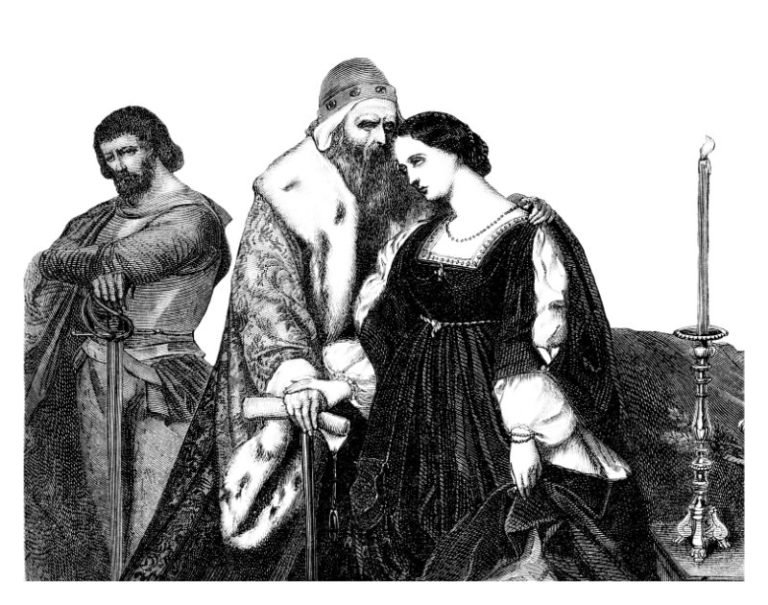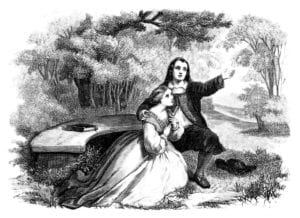The Publication of the Sonnets (1609)
It may be that, in some conservative minds, the Sonnets contain material that is personal and private, even somewhat compromising: Sonnet 129, as mentioned above, which opens with reference to ‘The expense of spirit in a waste of shame’, is believed to be about masturbation, and there are numerous other intimate sexual references in these poems.
The Sonnets had been long in preparation when they were finally published in 1609 – perhaps as long as two decades. A number had been printed under the title ‘The Passionate Pilgrim’ in 1598, but this was an act of piracy, and did not carry the author’s imprimatur.
For this reason, when they appear in full, they are given their unambiguous title: ‘Shakespeare’s Sonnets’. Is it a coincidence that Shakespeare’s mother died in 1608, thus releasing their author from any potential for embarrassment?
If so, what are we to make of the fact that his wife and two daughters were still alive?
Sword Fights in Shakespeare
Sword fights were dangerous to stage – and were no doubt popular with Shakespeare’s audiences partly for that reason. They are also among the most significant dramatic moments in his plays: Romeo’s fight with Tybalt triggers his expulsion from Verona, while Macduff’s defeat of Macbeth serves to avenge some of what has gone before.
Similarly, in ‘Henry IV Part Two’, Prince Hal confronts (and kills) Harry Hotspur at Shrewsbury to secure his succession, and in ‘Richard III’, Henry Tudor kills Richard III at Bosworth: both fights play a decisive role in events. Less decisive, perhaps, is the outcome of the sword fight in ‘Hamlet’, in which both participants, Laertes and Hamlet, are killed, along with both King and Queen.
‘The Winter’s Tale’ (1610)
Happily – given his tendency to set his plays abroad – Shakespeare’s command of geography is generally pretty secure. For example it is said that all the features of Verona identified in ‘Romeo and Juliet’ are visible to this day.
Perhaps Shakespeare really did spend his ‘lost years’ in Italy (as some have suggested) – though others believe he owed his local knowledge to an Italian polymath known to him, named John Florio, an associate (and employee) of Shakespeare’s patron, the Earl of Southampton.
Either way, as mentioned earlier, readers would be well-advised to treat the geography of ‘The Winter’s Tale’ with caution: Acts 3 and 4 follow the saintly Perdita over the seas by boat to the land-locked country of Bohemia.
Overcoming Obstacles to Marriage in Shakespeare
‘The course of true love never did run smooth’, notes Lysander in the opening scene of ‘A Midsummer Night’s Dream’, thus establishing the template for many of Shakespeare’s romances. For Lysander and Hermia (and Demetrius and Helena), confusion reigns when Puck administers the love-potion to the wrong target. Happily the mistake is corrected before the play ends, and love prevails.
Romance is never straightforward in Shakespeare: Romeo and Juliet are divided by long-standing family feuds. In ‘All’s Well’ it is social position (and Bertram’s prejudice) that keeps him from falling for Helena – until the play’s climax. In ‘Cymbeline’ it is exile in Italy that separates Posthumus from Imogen until the closing scene, and in ‘Much Ado’ it is a certain amour propre that keeps Benedick from Beatrice – if only temporarily. In ‘The Merchant of Venice’ it is the three mysterious caskets that separate Bassanio from Portia: he must pick the right one to win her hand in marriage.
The exception to the rule emerges in Shakespeare’s final play. Miranda and Ferdinand don’t have to work too hard to fall in love in ‘The Tempest’, and marriage will follow naturally under the benign direction of the magician Prospero.
Magic in Shakespeare
Belief in magic was beginning to wane in sixteenth-century England, but its potential dramatic power had lost none of its appeal.
In Shakespeare, magical powers are of two types. On one side appear those who have exceptional – if not supernatural – powers of perception: for example Joan la Pucelle in ‘Henry VI Part One’, who recognises people she has never met before, or the witch and the sorcerer in ‘Henry VI Part Two’, able to tell the future (even if their predictions are not fully understood). The archetype of supernatural perception is of course the witches in ‘Macbeth’, who make ten prophecies, all of which come true.
Then there are those characters with supernatural powers of action. Paulina in ‘The Winter’s Tale’, who brings Hermione back to life after two decades, is one such; a second is Friar Lawrence in ‘Romeo and Juliet’, who gives Juliet a concoction that enables her to appear dead for a precise period of time. Elsewhere Oberon’s ‘love-in-idleness’, a potion that persuades its victims to fall in love with the first person they meet, has still more magical (and dramatic) properties.
But perhaps the character most at ease with magic is the last one Shakespeare created: Prospero in ‘The Tempest’, who uses magic to right past wrongs, then abandons his art on his return to the real world.
‘The History of Cardenio’ (1613)
An entry in the Stationers’ Register of 1653 records the existence of a play by John Fletcher and William Shakespeare named ‘The History of Cardenio’. This play is known to have been performed by the King’s Men in 1613, around the time Shakespeare and Fletcher were collaborating on plays like ‘The Two Noble Kinsmen’, but sadly no manuscript survives.
Cardenio was originally a character in ‘Don Quixote’, which had been translated into English and published in 1612. A century later, ‘Cardenio’ was claimed as the inspiration for a play entitled ‘Double Falsehood’ by one Lewis Theobald, though without the original, it’s impossible to assess any points of similarity or influence.
The original may now be lost, but modern scholarship believes it was indeed co-written by Fletcher and one other playwright – identity unknown.
Shakespeare’s Signature
It’s curious that the world’s most famous writer spells his own name in different ways in the six signatures that survive.
In 1612, a witness in a court case arising from his days as a lodger on Silver Street, he is ‘Willm Shakp’, and the following year, buying property in Blackfriars, he is ‘Wm Shakspe’ and ‘Willm Shaksper’.
Three years later, finalising his will in the Spring of 1616, he is variously ‘Willm Shakspere’ (twice) and ‘William Shakspeare’. These six signatures are the only surviving examples of his handwriting – other than the contentious but compelling case of the speech to the xenophobic mob in ‘Sir Thomas More’ (see #14).
Shakespeare’s Tomb
On Shakespeare’s tomb in Stratford may be observed a coat of arms: a spear on a shield below a helmet. This somewhat militaristic heraldry was acquired by the playwright in the late 1590s, apparently as a gift to his father, who had enquired about just such a display some twenty years before.
That project had come to nothing – perhaps for financial reasons, though perhaps the authorities were discouraged from accommodating Shakespeare Sr owing to his extant Catholic connections – so his son’s acquisition of the arms was either a statement of his success in London and his ascent up the class system on the back of his riches, or else a general declaration of his religious respectability.
The coat of arms glories in the legend ‘Non Sanz Droict’ – Norman French for ‘Not without right’. In 1599 Shakespeare’s rival Ben Jonson wrote ‘Every Man Out Of His Humour’, a play in which the bucolic Sogliardo attaches to his coat of arms the motto ‘Not without mustard’.
The First Folio (1623)
Around half of Shakespeare’s plays would not have survived without the First Folio, published in 1623, seven years after his death.
This volume was the brainchild of John Heminges and Henry Condell, actors in the King’s Men, who recognised that without urgent action, around half of Shakespeare’s plays, extant in manuscript form only, might be lost to posterity.
The First Folio collected 36 plays into a print run of 800, priced at one pound each. A copy of the First Folio was recently sold at Christie’s for just under ten million dollars.
Categorising Shakespeare’s Plays (1623)
The instinct to categorise Shakespeare’s plays begins with the publication of the First Folio, which (see #115) rescued any number of seminal texts – ‘Macbeth’, ‘The Tempest’, ‘A Midsummer Night’s Dream’ – from oblivion. The First Folio divides the plays between Comedies, Histories and Tragedies – categories that have proved remarkably durable.
A different approach might be to distinguish between Elizabethan Shakespeare (to 1603) and his Jacobean successor (1603 – 1613). It’s said that life under James – louche, sensual, homosocial – suited Shakespeare a great deal better than the prim atmosphere that prevailed at Elizabeth’s court (though equally the 1590s saw no shortage of sexual and other scandals there).
Even so, it is striking how much darker Shakespeare’s plays become in the second half of his career: ‘Coriolanus’, ‘Timon of Athens’.
Making Money out of Shakespeare
When William Jaggard collected together a handful of poems in the late 1590s and published them as ‘The Passionate Pilgrim’ under the name of William Shakespeare, he was launching a process that continues unabated to this day and isn’t going to stop any time soon: making money out of the name of William Shakespeare.
The figures speak for themselves: Shakespeare is the best-selling author of all time, with book sales believed to be between two and four billion. The number of children and school students studying Shakespeare’s plays worldwide is around 64 million. The value of the Shakespeare brand is approaching 500 million dollars.
The area of the English West Midlands known as Shakespeare’s England welcomes around ten million tourists every year. The value to the local economy of the link with Shakespeare is between 500 million and a billion pounds per annum. Over ten thousand jobs depend on the association with Shakespeare’s name.
Overall, Shakespeare has generated a global tourism industry worth over £125 billion pounds. Incidentally, ‘The Passionate Pilgrim’, when originally published, retailed for one shilling – in today’s money, 5p.
Re-writing the Sonnets (1640)
The first 126 of Shakespeare’s Sonnets are famously dedicated to the ‘fair youth’ – whose identity remains, four centuries later, the subject of frenzied debate and disagreement. What is beyond dispute is his gender: these often passionate love poems are addressed to and inspired by a young man.
Unsurprisingly, this has proved problematical for some later readers. In 1640 a book-seller called John Benson produced an edition of the sonnets in which the pronoun ‘he’ was routinely changed to ‘she’, and phrases like ‘sweet boy’ became ‘sweet love’. Where compromise was impossible, the recalcitrant sonnet was simply omitted, as happened to sonnet 126 (‘O thou my lovely boy …’).
Benson’s edition of the sonnets remained current for over a century, while the anxieties that produced it lasted into the Victorian era and beyond.
Shakespeare’s Signet Ring
A signet ring with the initials WS was discovered in a field near Holy Trinity church in Stratford on Avon in the spring of 1810. Once the ring had been cleaned, analysis of the decorative design accompanying these very suggestive initials revealed that the ring had belonged to a wealthy Elizabethan gentleman, identity unknown.
The provenance of the ring has never been established (though it is accepted that one possible candidate, William Smith of Stratford, was not its owner). But it is notable that when, in his will, Shakespeare had originally included the phrase ‘whereof I have hereunto put my hand and seal’, the words ‘and seal’ have been crossed out.
One theory is that the ring may have been given to Shakespeare by his wife at his wedding. If so there is a certain irony in the suggestion that it may have been lost at the marriage of his younger daughter Judith at Holy Trinity church in 1616.
The Robben Island Bible
The most senior and distinguished political prisoners during the era of apartheid in South Africa were incarcerated on Robben Island off Cape Town. Nelson Mandela was among those imprisoned on the island, where he was held for some 27 years.
His fellow dissidents kept a copy of the Complete Works of Shakespeare, a volume which needed at times to be kept hidden from the authorities. The book, known as The Robben Island Bible, was passed around between the prisoners, who agreed to sign the passage which resonated most strongly with them. Mandela chose a passage from ‘Julius Caesar’: ‘Cowards die many times before their deaths’, it runs. ‘The valiant never taste of death but once’.
Mandela was released from Robben Island in 1990, and elected president of South Africa in 1994. Widely revered for his non-violent (and valiant) response to apartheid, he died in 2013.




